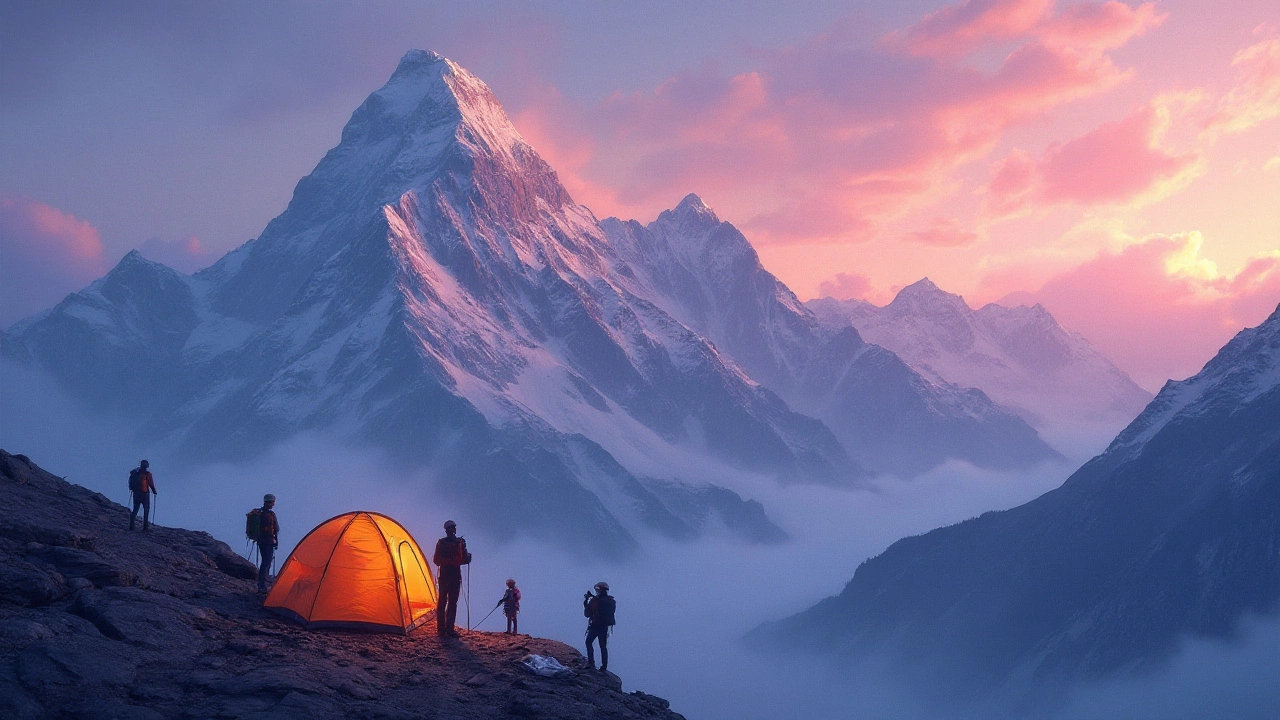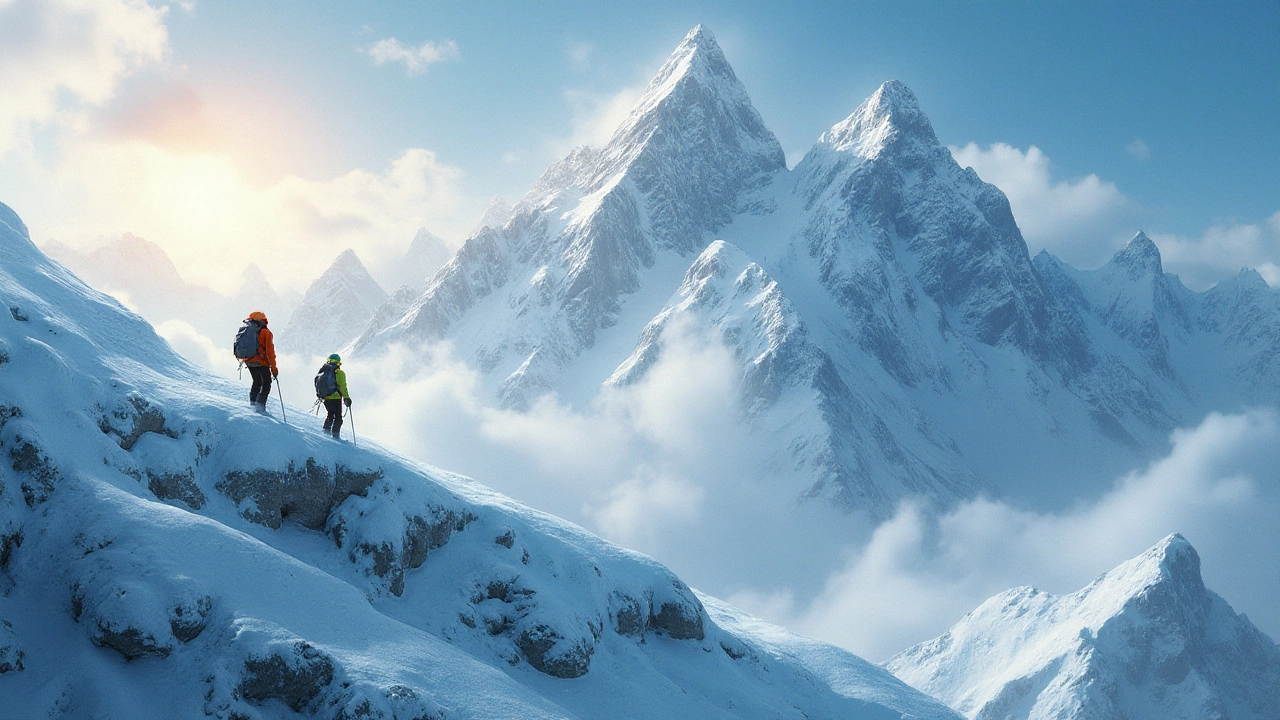Mountain climbing in India is not merely a trek; it's an odyssey into the wild heart of nature where the sky meets the earth. These peaks embody mystery, excitement, and daunting challenges that intrigue adventurers from across the globe.
For those with a spirit of adventure, India offers some of the world's most formidable mountain climbs. Each peak stands as a monument to both natural beauty and the limits of human endurance. Climbing these formidable heights is no small feat and requires preparation, skill, and an unyielding spirit.
Join us as we explore India's toughest peak to climb and discover what makes it the apex of challenge and allure for climbers everywhere.
- The Pinnacle of Challenge: Nanda Devi
- The Enigmatic K2: Inaccessible Pinnacle
- The Myth of Kanchenjunga
- Practical Tips for Climbing India's Peaks
The Pinnacle of Challenge: Nanda Devi
Nanda Devi has long claimed a significant place in the heart of trekkers across the globe. Known as India’s second highest peak and towering at an awe-inspiring elevation of 7,816 meters, this majestic mountain is not just another climb; it is a sacred journey into one of nature's truly untouched realms. Nestled in the state of Uttarakhand, Nanda Devi is often associated with its poetic name, translated as “Bliss-Giving Goddess.” The peak lies within the core of the Nanda Devi National Park, a UNESCO World Heritage site, which itself is considered one of the most secluded spaces on earth.
The journey to Nanda Devi is not merely about reaching the summit; it's an exploration of India's rich natural tapestry that intertwines daunting challenges with overwhelming beauty. Since its first ascent in 1936, many climbers have been captivated by its allure, but accessing the inner sanctuary where the peak lies remains restricted to preserve its delicate environment. This adds an extra layer of intrigue and desirability for mountaineers keen on pushing their limits.
"Climbing Nanda Devi isn't just a test of your physical abilities; it's an all-encompassing experience that demands both respect and humility," once remarked a renowned alpinist who attempted its ascent.
What makes climbing India trekking peaks like Nanda Devi so challenging is not just the altitude or the technical skill required, but also the unpredictable weather conditions. One must be prepared for sudden snowfall, high winds, and severe temperature drops, all of which can occur within a single day. The climb involves traversing through a series of hostile terrains including craggy cliffs and deep valleys which require precision and fearless navigation. Many ascend with a pupose, motivated by both personal challenge and the tales of previous climbers who found the summit equally rewarding and punishing.
The mountain is surrounded by an aura of mysticism, with local folklore enriching its mythos. The cultural significance of the mountain is deeply woven into the lives of indigenous communities who revere the peak as a deity and protector. These cultural dimensions add layers of meaning to the climb that transcend mere physical conquest. Whether one succeeds in reaching the summit or not, the climb itself offers a transformative experience, imbued with personal reflection and reverence for the majestic wilderness of the mountain climbing India.
Attempting Nanda Devi requires thorough preparation and adherence to stringent rules established to protect the environmental sanctity of the region. Climbing permits are difficult to obtain, and any attempt to scale its icy heights should be led by experienced guides who understand both the topography and its unpredictable patterns. Thus, setting off for Nanda Devi is not a task for the ill-prepared or the feint-hearted. It calls to those ready to embrace the unknown with respect and anticipation.
The Enigmatic K2: Inaccessible Pinnacle
Among the celestial giants that loom over the Indian subcontinent, K2, also known as Mount Godwin-Austen, stands as perhaps the most formidable. While technically positioned on the border of Pakistan and China and part of the Greater Himalayas, it's often a topic of conversation for India's trekking peaks due to the shared cultural and geographical tapestry of the region. K2, the second-highest peak in the world after Mount Everest, holds an allure that is steeped in both majestic beauty and the ominous promise of peril.
Renowned climbers often speak of K2 with a voice tinged with both reverence and fear. Its steepness, unpredictable weather, and challenging ice faces make it notoriously difficult among mountain climbers. Legendary Italian mountaineer Reinhold Messner famously remarked, "K2 is indeed the end of the world without mercy," capturing the essence of its daunting challenge. The mountain's nickname, "The Savage Mountain," speaks volumes about its ferocity, with many tales of attempted ascents met with dramatic challenges and heart-wrenching losses.
The climb itself offers no shortcuts; climbers taking on K2 do so with the knowledge that every step must be calculated meticulously. The harsh weather conditions with sudden storms, extreme cold, and the ever-present threat of avalanches, make it a true test of both endurance and skill. Unlike Everest, which has been commercialized to some extent, K2 provides no luxury, no comforting base camps brimming with amenities, only solitude and the constant reminder of nature's overwhelming power. K2 demands respect and offers little mercy for typographical errors in judgment.
"The mountain shrugged me off..." shared renowned climber Scott Fisher in describing his failed attempt at K2. His words remain a poignant reminder of the unpredictable wildness that the mountain encompasses.Summiting K2 is not just about physical strength but mental endurance. Climbers speak of the need for a calm, calculated mindset, where quick decision-making can mean the difference between life and death. It is the dream of many a climber to conquer K2, and yet it is a dream that humbles. The success rate on K2 is significantly lower, with the mountain boasting one of the highest fatality-to-summit ratios among the world's tallest peaks.
For those enticed by an epic adventure into the heart of the Himalayas, preparation for trekking India’s peaks like K2 must be meticulous. Building both technical climbing skills and physical conditioning is only the beginning. Climbers must also be ruggedly self-sufficient, prepared for self-rescue, and strategic in supply management for the journey. The reward, they say, is unparalleled, as the summit offers views of an untouched world, a testament to one's mettle and humanity’s unyielding pursuit of pushing beyond the known boundaries.

The Myth of Kanchenjunga
Kanchenjunga, the majestic peak that reigns as the third tallest mountain in the world, is not only a pinnacle of nature’s artistry but a tapestry woven richly with legend and myth. Towering at 8,586 meters, this colossus of ice and rock is much revered in the Indian landscape. Located in the eastern Himalayas, it straddles the borders of Nepal and India's Sikkim state and is a part of the esteemed Great Himalayan Range. While climbers laud its daunting ascents, the local cultures preserve its divine narrative.
In Sikkim, Kanchenjunga is more than a peak; it symbolizes the five treasures of the snows, representing gold, silver, gems, grain, and holy books. Hence, it holds spiritual significance that transcends the physical challenge associated with attempting its ascent. Respecting this sacredness, expeditions traditionally avoid setting foot on its summit, reflecting a mutual accord between adventurers and the indigenous customs. The reverence commands that climbers halt a few steps short of the peak. This unwritten rule today ensures that the soul of Kanchenjunga, the threshold between the earthly and the ethereal, remains untarnished by human triumph.
The climb itself is notorious for its intensity. Unlike more trodden routes like Everest’s, ascending Kanchenjunga involves technical prowess, resilience, and a willpower that must combat unpredictable weather patterns, extreme altitudes, and isolated paths. On the climbing circuit, it is considered a less-frequented route, testing climbers against the merciless elements in a profound solitude. According to statistical reports, fewer than 300 climbers have dared to scale this giant, an indication of its fearsome reputation.
K2, while often revered for its sheer difficulty, is akin to Kanchenjunga's own formidable path, yet it lacks the cultural enrichments teeming within Kanchenjunga's steeped histories. As climbers trek, they are not only imbibing the serenity of white-clad ridges but stepping through a corridor of past tales and spiritualism that shape the mountain’s essence. As Reinhold Messner, the legendary Italian climber, once remarked, “Mountains are not fair or unfair, they are just dangerous.”
Kanchenjunga reminds climbers to tread softly and carry with them the stories whispering through the cool Himalayan winds.
For those seeking to challenge themselves on one of the hardest peaks to climb, preparing to traverse Kanchenjunga is a commitment that stretches far beyond physical fitness into a preparation of the heart and mind. Essential gear, proper acclimatization, and the guidance of experienced local sherpas become a climber's trinity. Yet, as many have reflected, the ascent is as much about the internal journey as it is about scaling altitudes. It's a pilgrimage through myth, nature, and one's own limits—an expedition that seeks not only the summit but an understanding of the intertwining beauty of nature and culture.
Practical Tips for Climbing India's Peaks
Climbing any of India's formidable peaks, such as the hardest peak to climb, requires much more than just physical stamina. The success of such an expedition is grounded in thorough preparation and an understanding of the unique challenges posed by each mountain. Whether you're setting out to conquer the legendary Nanda Devi or the enigma of K2, preparation is paramount. Begin by investing time in research; learn about the specific terrain, weather patterns, and acclimatization needs of your chosen peak. Speak to veteran climbers and utilize forums and climbing communities for first-hand insights. Building your skill set through climbing schools can offer invaluable lessons and ensure you are mentally and physically prepared for any situation the mountain might throw at you.
When it comes to gear, quality is not a compromise. From sturdy hiking boots that protect and stabilize your feet on rugged terrain, to clothing that layers for various weather conditions, every piece plays a critical role in your safety and comfort. Many climbing experts emphasize the necessity of testing your gear in less challenging conditions to ensure reliability under the demanding environments of the Indian mountains. Don't forget the essentials, such as a portable water purifier, high-energy snacks, and a fully-stocked first-aid kit. Consider satellite communication devices for emergency contact and navigation tools like compasses and GPS, as these can be the difference between ease and difficulty amid nature’s wilderness.
Nutrition and hydration are the lifelines of a successful climb. A nutrition plan that keeps you energized is indispensable when facing long days of exertion. Incorporate a diet rich in carbohydrates, proteins, and fats leading up to and during the climb. Hydration cannot be overlooked as altitude sickness—a real threat at high elevations—can often be alleviated by maintaining ample water intake. It is recommended to drink steadily throughout your ascent to prevent dehydration and aid in acclimatization. A handy tip shared often is to climb high and sleep low, letting your body process the altitude changes efficiently.
"The mountain always speaks to you through its weather. It teaches patience, endurance, and above all, humility," says renowned mountaineer Arjun Vajpai. Take these sentiments seriously and have contingency plans for bad weather spells. Remember, there are no exact substitutes for live information, so maintaining contact with base camp and having local guides who intimately know the varied terrains can often offer peace of mind and swift solutions to unexpected challenges.
Lastly, understanding and respecting the cultural and environmental ethos of the area is crucial. Indian peaks often carry mythological and spiritual significance, requiring climbers to tread respectfully and responsibly. Moreover, adhere to sustainable practices—such as carrying out your trash and minimizing impact—to protect the pristine beauty and maintain harmony with the local communities. With these practical tips and a resilient mindset, your journey to climb India's peaks can be as enriching and unforgettable as the summit itself.
